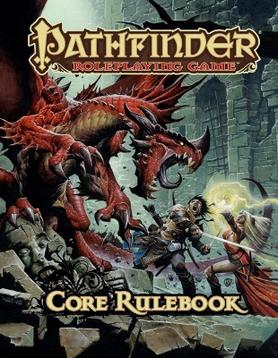
Burials of Teganshire Post 19 of 30
Bound accuracy is the D&D 5E concept in which the escalator ramp of bonuses caps out, thereby simplifying game attributes like armor class, attack bonuses, skill checks, what have you. It’s cool, I like it, and Pathfinder 1E doesn’t have it, and I don’t care. So, why bring it up?
Bound accuracy dramatically simplifies things for the player and DM. Still, it muddies the waters when it comes to designing 5E encounters because it places a significant burden on the DM for making things hard and challenging. Pathfinder 1E, with well-established escalation calculations, it does not suffer, for the most part, from this design burden.
But we can steal other concepts from 5E. We just need to be a mite bit careful because of that very lack of bound accuracy.
Recap: the Pathfinder 1E Action Economy Dominates Everything
Three conical sources explained the Pathfinder 1E action economy, available some time ago:
ACTION ECONOMICS 101: https://gamingeveryman.wordpress.com/2014/02/24/55/
ACTION ECONOMICS 102: https://gamingeveryman.wordpress.com/2014/03/03/action-economics-102/
And the highly recommended parent, original PDF: https://img.fireden.net/tg/image/1460/77/1460773144850.pdf
All by Alexander Augunas.
The gist is summed up here:
4. The game is built with the assumption that the PCs will win an encounter, and it isn’t until CR +4 that the encounter is a fair fight between the PCs and their opponents. We can prove this because placing a party against a Linear Guild party is always a CR +4 encounter.
5. The most effective way to design challenging encounters is to overwhelm the action economy in the antagonist’s favor. When the enemies have more actions than the PCs or the PCs’ actions are restricted, encounters are challenging.
Just like in 5E, the “Deadly” encounter CR (CR+4) is where the killing monsters portion of Pathfinder becomes fun.
Tweak the Pathfinder Action Economy for Your Villains with these 5E Mechanics
In Pathfinder, talking an Encounter from CR+4 to CR+5 can result in mass casualties at your game table due to the absence of bound accuracy (as noted above). But as the three articles by Alexander explain, challenging your PCs really starts with putting the antagonist ahead of the action economy curve. Using 5E Legendary, Lair, and Villain actions are a great way of maintaining the CR+4 encounter math and ramping up the difficulty.
As long as we avoid the pitfall of raising the CR with extra attacks.
Pitfall First
In Pathfinder, a CR+4 encounter probably has enough attacks to seriously damage a party. Adding additional attacks on initiative 20 (Lair actions), and after a PC (Legendary actions) can elevate the encounter beyond the CR+4 rule-of-thumb, more so than 5E. Depending on party class makeup, however, your PCs may be able to absorb that.
Add Legendary Actions to the Primary Monster
Either solo or with some buddies, Legendary Actions ramp-up the BBEG Action Economy:
At the end of another creature’s turn, a creature can use a legendary action. A creature with legendary actions has separate actions it can choose from. Each one costs a different amount of “actions.” Only one legendary action can be used at a time, and the creature cannot use legendary actions while incapacitated. The creature regains its legendary actions at the start of its next turn.
Legendary Actions Example
Here are some Legendary action examples that aren’t concerned with dealing a ton of damage. Every round, the BBEG gets 3 Legendary Actions:
- Performs a swift action (Cost: 1)
- Casts a cantrip (Cost: 1)
- Move rated movement speed without provoking an attack of opportunity (Cost: 1)
- Remove all detrimental conditions such as grappled, stunned, prone, etc. (Cost: 2)
- All enemies within 15ft. are automatically pushed 15ft away from the Legendary creature (Cost: 3)
- Target an enemy with a ranged attack without provoking an attack of opportunity (Cost: 1)
- Webs fall from the ceiling in a 30ft. diameter area (Cost: 2)
- BBEG goes invisible and dimension doors (Cost: 3)
Legendary action reference: https://duckduckgo.com/?q=5E+legendary+action
Add Lair Actions to Monster Lairs
Lair Actions occur on initiative count 20, (losing all ties). The monster can’t use the same effect two rounds in a row.
Lair Actions Example
Let’s use the lich from the 5E System Reference Document:
- The lich rolls a d8 and regains a spell slot of that level or lower. If it has no spent spell slots of that level or lower, nothing happens.
- The lich targets one creature it can see within 30 feet of it. A crackling cord of negative energy tethers the lich to the target. Whenever the lich takes damage, the target must make a DC 18 Constitution saving throw. On a failed save, the lich takes half the damage (rounded down), and the target takes the remaining damage. This tether lasts until initiative count 20 on the next round or until the lich, or the target is no longer in the lich’s lair.
- The lich calls forth the spirits of creatures that died in its lair. These apparitions materialize and attack one creature that the lich can see within 60 feet of it. The target must succeed on a DC 18 Constitution saving throw, taking 52 (15d6) necrotic damage on a failed save, or half as much damage on a success. The apparitions then disappear.
We can modify that for Pathfinder 1E:
- The lich rolls a d8 and regains a spent spell that level or lower. If it has no spent spell of that level or lower, nothing happens.
- The lich targets one creature it can see within 30 feet of it. A crackling cord of negative energy tethers the lich to the target. Whenever the lich takes damage, the target must make a DC 20 Fortitude saving throw. On a failed save, the lich takes half the damage (rounded down), and the target takes the remaining damage. This tether lasts until initiative count 20 on the next round or until the lich, or the target is no longer in the lich’s lair.
- The lich calls forth the spirits of creatures that died in its lair. These apparitions materialize and attack one creature that the lich can see within 60 feet of it. The target must succeed on a DC 20 Fortitude saving throw, taking 30 points of negative energy damage on a failed save, or half as much damage on a success. The apparitions then disappear.
More on Lair Actions: https://duckduckgo.com/?q=5E+lair+actions
Add Villain Actions to Your Villainous Villains
What’s a villain action, you might ask? Watch this video, and it explains all. I’ve seen Matt use it and I’ve also used it, and it rules. Literally!
Ahem, sorry. Rule of thumb: pretend the monster is only going to last three rounds. Design accordingly. While this video is 5E specific, the majority of it applies to any D20 D&D derivative, such as 3.5 and Pathfinder 1E.
Action Conclusion
In Pathfinder 1E, there are tons of monsters, tons of villains, tons of adventure modules, tons of just about anything a GM could ever want or need.
The mechanics of the action economy does not change with all of those resources. CR+4 is your gold standard, and consider Legendary, Lair, and Villain actions an easy way to add not just flair, but adds actions to keep ahead of the PCs’ action curve.
Our Indiegogo campaign ends soon, back today!

Crossbow Man’s Action Economy Consists of Bolts. Many, many bolts.
Previous 30 Days of BoT | Next 30 Days of BoT















